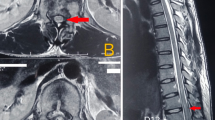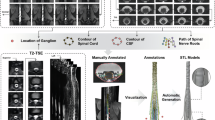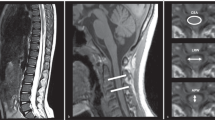Abstract
Study design:
A case report of a female patient who sustained injury to the thoracic spinal cord as a direct result of thoracolumbar selective nerve root block.
Objective:
To raise the awareness that selective nerve root infiltration, a very common procedure in a pre-existing deformity, may cause injury to the spinal cord with dire consequences, albeit rarely.
Case report:
An 82-year-old retired nurse (who had sustained osteoporotic compression fractures of the T12 vertebra) who presented with a 2-year history of continuous low back pain following a fall into a pothole. Immediately after image-guided, transforaminal infiltration of left side T12 root the patient developed sudden onset of complete motor and sensory T10 level flaccid paraplegia. No abnormality was noted on T2 magnetic resonance imaging (MRI) of the spine on the same day. Eleven days later, T2 MRI of the spine with gadolinium contrast revealed an increased fluid signal in conus medullaris. At 2-year follow-up, the neurological improvement has been good (L2 level American Spinal Injury Association/International Spinal Cord Society (ASIA/ISCoS) neurological standard scale (AIS) D paraplegia), urinary and sensory disorders are still present.
Conclusion:
Injury to the spinal cord is known to occur in interventions such as epidural steroid infiltrations. Over time, pain management in relation to the new and emerging interventions on spine have changed. What might not be appreciated is the awareness that such interventions may cause injury to the spinal cord with serious consequences. Despite potential occurrence, in the case reported here, the neurological and functional prognosis is good with an expert, early and appropriate management in a spinal injuries centre.
Similar content being viewed by others
Log in or create a free account to read this content
Gain free access to this article, as well as selected content from this journal and more on nature.com
or
References
Thefenne L, Dubecq C, Zing E, Rogez D, Soula M, Escobar E et al. A rare case of paraplegia complicating a lumbar epidural infiltration. Ann Phys Rehabil Med 2010; 53: 575–583
Houten JK, Errico TJ . Paraplegia after lumbosacral nerve root block: report of three cases. Spine J 2002; 2: 70–75.
Ram S, Osman A, Cassar-Pullicino VN, Short DJ, Masry WE . Spinal cord infarction secondary to intervertebral foraminal disease. Spinal Cord 2004; 42: 481–484.
Staal JB, de Bie R, de Vet HCW, Hildebrandt J, Nelemans P Injection therapy for subacute and chronic low-back pain. Cochrane Database of Systematic Reviews 2008, Issue 3. Art. No: CD001824.
Chang-Chien GC, Knezevic NN, McCormick Z, Chu SK, Trescot AM, Candido KD et al. Transforaminal versus interlaminar approaches to epidural steroid injections: a systematic review of comparative studies for lumbosacral radicular pain. Pain Physician 2014; 17: E509–E524.
Acknowledgements
I thank Professor W El Masri, Mr A Osman, Mr J R Chowdhury, Mr S Bandi and other medical staff, all the nurses, psychologists, occupational and physiotherapists for their support in enabling the collection of the data without which the publication of this paper would not have been possible.
Author information
Authors and Affiliations
Corresponding author
Ethics declarations
Competing interests
The author declares no conflict of interest.
Rights and permissions
About this article
Cite this article
Kumar, N. Spinal cord injury complicating a thoracolumbar selective nerve root block in a deformed spine: neurological and functional outcome. Spinal Cord 53 (Suppl 1), S3–S5 (2015). https://doi.org/10.1038/sc.2014.180
Received:
Revised:
Accepted:
Published:
Issue date:
DOI: https://doi.org/10.1038/sc.2014.180
This article is cited by
-
Dexamethasone
Reactions Weekly (2015)



